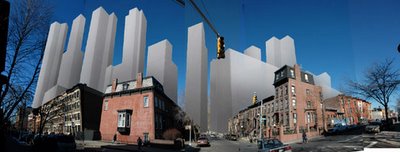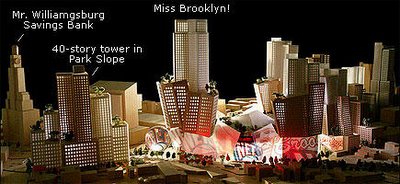 In the lead article in today's New York Times Week in Review, architecture critic Nicolai Ouroussoff offers a Critic's Notebook, headlined Outgrowing Jane Jacobs, arguing, as he has done in the past, that a veneration for Jacobs precludes us from embracing more ambitious projects that address challenges unforeseen during Jacobs's heyday more than 40 years ago.
In the lead article in today's New York Times Week in Review, architecture critic Nicolai Ouroussoff offers a Critic's Notebook, headlined Outgrowing Jane Jacobs, arguing, as he has done in the past, that a veneration for Jacobs precludes us from embracing more ambitious projects that address challenges unforeseen during Jacobs's heyday more than 40 years ago.Ouroussoff makes some provocative points and, read through a Brooklyn-centric lens, it's hard not to sense a defense of the Frank Gehry-designed Atlantic Yards project. Curiously, though the critic's most recently-published criticism of Jacobs came in his 7/5/05 assessment of the Atlantic Yards design, and in January he defended Gehry's design publicly--even denying that it would include a superblock--he chose not to mention the project in today's essay.
 Ouroussoff wrote:
Ouroussoff wrote:Time passes. Jane Jacobs, the great lover of cities who stared down Robert Moses' bulldozers and saved many of New York's most precious neighborhoods, died last week at 89. It is a loss for those who value urban life. But her death may also give us permission to move on, to let go of the obsessive belief that Ms. Jacobs held the answer to every evil that faces the contemporary city.
For New Yorkers, Ms. Jacobs's life remains suspended between two seismic events: The publication, in 1961, of ''The Death and Life of Great American Cities'' and her showdown in the late 60's with Mr. Moses over a proposed Lower Manhattan Expressway that would have reduced much of SoHo's handsome cast-iron district to rubble. The expressway was killed by Mayor John V. Lindsay in 1969.
By then, Ms. Jacobs had fled for Toronto, and Mr. Moses, who died in 1981, had lost much of his power and prestige. But in the popular imagination, the two are forever at odds: the imperious city planning czar versus the tireless public advocate. Today, the pendulum of opinion has swung so far in favor of Ms. Jacobs that it has distorted the public's understanding of urban planning. As we mourn her death, we may want to mourn a bit for Mr. Moses as well. (Emphasis added.)
 Regarding Atlantic Yards, however, the urban planning has been privatized and "backwards." No RFP was ever issued. The project was announced and endorsed by local officials without any public discussion of the potential use for the Metropolitan Transportation Authority's Vanderbilt Yard (8.3 acres of the 22-acre site footprint), and it took 18 months before the railyard was put out to bid. The scale of the project exceeds city zoning but, because city officials agreed to let Atlantic Yards be a state project, the Empire State Development Corporation (ESDC) can override city zoning. (Mockup from OnNYTurf.)
Regarding Atlantic Yards, however, the urban planning has been privatized and "backwards." No RFP was ever issued. The project was announced and endorsed by local officials without any public discussion of the potential use for the Metropolitan Transportation Authority's Vanderbilt Yard (8.3 acres of the 22-acre site footprint), and it took 18 months before the railyard was put out to bid. The scale of the project exceeds city zoning but, because city officials agreed to let Atlantic Yards be a state project, the Empire State Development Corporation (ESDC) can override city zoning. (Mockup from OnNYTurf.)Small-scale challenges
Ouroussoff continued:
Her argument was simple enough, radically so. Horrified at the tabula rasa urban renewal strategies of the 1950's, she argued for a return to the small-scale city she found in Greenwich Village and the North End of Boston -- the lively street life of front stoops, corner shops and casual personal interaction.
...But the problems of the 20th-century city were vast and complicated. Ms. Jacobs had few answers for suburban sprawl or the nation's dependence on cars, which remains critical to the development of American cities. She could not see that the same freeway that isolated her beloved, working-class North End from downtown Boston also protected it from gentrification. And she never understood cities like Los Angeles, whose beauty stems from the heroic scale of its freeways and its strange interweaving of man-made and natural environments.
The threats facing the contemporary city are not what they were when she first formed her ideas, now nearly 50 years ago. The activists of Ms. Jacobs's generation may have saved SoHo from Mr. Moses' bulldozers, but they could not stop it from becoming an open-air mall.
...Nor did Ms. Jacobs really offer an adequate long-term solution for the boom in urban population, which cannot be solved simply through incremental growth in existing neighborhoods.
Indeed, there's a compelling argument for development at significant density over the railyards. However, the community-developed UNITY plan called for towers at about half the scale of Gehry's plan, plus additional streets to extend the urban fabric. This should have been a topic for public discussion.
Eyes wide open?
Ouroussoff offered some defenses of development:
Just as cities change, so do our perceptions of them. Architects now in their mid-40's -- Ms. Jacobs's age when she published ''Death and Life'' -- do not share their parents' unqualified hatred of Modernist developments.
They understand that an endless grid of brick towers and barren plazas is dehumanizing. But on an urban island packed with visual noise, the plaza at Lincoln Center -- or even at the old World Trade Center -- can be a welcome contrast in scale, a moment of haunting silence amid the chaos. Similarly, the shimmering glass towers that frame lower Park Avenue are awe-inspiring precisely because they offer a sharp contrast to the quiet tree-lined streets of the Upper East Side.
...The lesson we should take from Ms. Jacobs was her ability to look at the city with her eyes wide open, without rigid prejudices. Maybe we should see where that lesson leads next.
There was Ouroussoff defending the World Trade Center superblock when even New York City Economic Development Corporation President Andrew Alper--a booster of the Atlantic Yards project--recently acknowledged the WTC design defects, as if it were settled wisdom: "Of course the huge footprint, the superblock, divided Lower Manhattan and hurt the streetscape."
As noted, Ouroussoff did not mention Atlantic Yards as an example. His reference to Jacobs's ability to look at the city fresh might be coupled with Paul Goldberger's reference to her disdain for disingenuousness. And that might lead Ouroussoff to question, if not Frank Gehry's plan, the developer behind it.
Cohn's take on Ouroussoff
Architect Jonathan Cohn commented that Ouroussoff has it wrong:
In today’s Times, Nicolai Ouroussoff looks for ways to criticize Jane Jacobs, largely by attacking the straw-man New Urbanists. It takes guts to write about the “beauty” of Los Angeles caused by the freeways, and to idealize the former World Trade Center plaza. But to suggest that SoHo is really just the same as the superblock misses the concept of how scale matters. And to criticize Ms. Jacobs because “she could not see that the same freeway that isolated her beloved, working-class North End from downtown Boston also protected it from gentrification” is a pretty strange defense of the Robert Moses mindset. Looking for beneficial unintended consequences of this bad idea is like pointing out that the redeeming quality of bad schools is that their students won’t have to worry about paying higher income taxes if/when they get jobs.
Kunstler and others
Author and critic James Howard Kunstler (The Geography of Nowhere) called Ouroussoff's essay a "load of vicious and stupid fashionista crap." His point:
In dissing Jacobs, Ouroussoff invokes the memory of the World Trade Center as a "welcome contrast in scale" to the rest of Manhattan. Similarly," he writes, "the shimmering glass towers that frame lower Park Avenue are awe-inspiring precisely because they offer a sharp contrast to the quiet tree-lined streets of the Upper East Side." Pure bullshit. The twin tower buildings themselves were boring, grandiose death-traps, and the plaza between them was for thirty years a sterile wasteland of shearing winds, avoided even by winos, an object lesson in the failures of Modernist public space design.
These buildings, and the voids of empty space they entailed, were suited to exactly the culture of myrmidons we became in the late 20th century, which is to say of enterprises such as the New York Times. Jane Jacobs knew better than that, and she said it powerfully.
Author David Sucher (City Comforts) dismissed the Times piece:
(Ourousoff's article today is so pathetic and filled with inaccuracies that I will not spend my valuable time on earth addressing it.)
The Gutter praised Ouroussoff, generating a furious response.
Rereading Ouroussoff
 In his 7/5/05 assessment of the Atlantic Yards plan (Seeking First to Reinvent the Sports Arena, and Then Brooklyn), Ouroussoff wrote:
In his 7/5/05 assessment of the Atlantic Yards plan (Seeking First to Reinvent the Sports Arena, and Then Brooklyn), Ouroussoff wrote:Frank Gehry's new design for a 21-acre corridor of high-rise towers anchored by the 19,000-seat Nets arena in Brooklyn may be the most important urban development plan proposed in New York City in decades. If it is approved, it will radically alter the Brooklyn skyline, reaffirming the borough's emergence as a legitimate cultural rival to Manhattan.
More significant, however, Mr. Gehry's towering composition of clashing, undulating forms is an intriguing attempt to overturn a half-century's worth of failed urban planning ideas. What is unfolding is an urban model of remarkable richness and texture, one that could begin to inject energy into the bloodless formulas that are slowly draining our cities of their vitality. It is a stark contrast to the proposed development of the West Side of Manhattan, where the abandoned Jets stadium was only the most visible aspect of what seemed doomed to become another urban wasteland.
From the dehumanizing Modernist superblocks of the 1960's to the cloying artificiality of postmodern visions like Battery Park City, architects have labored to come up with a formula for large-scale housing development that is not cold, sterile and lifeless. Mostly, they have failed.
There are those -- especially acolytes of the urbanist Jane Jacobs -- who will complain about the development's humongous size. But cities attain their beauty from their mix of scales; one could see the development's thrusting forms as a representation of Brooklyn's cultural flowering.
There was no acknowledgement of zoning and the appropriate scale for this project. Yes, he's right that a mix of scales could be welcome. But who gets to decide the appropriate scale? (Graphic of earlier version of plan from 7/5/05 New York Times, with addenda by NoLandGrab.org.)
Responding to Ouroussoff
In a 7/11/05 letter to the editor, noted sociologist Nathan Glazer wrote:
Nicolai Ouroussoff is engaged in a misguided war with Jane Jacobs: there is no ''quaintness'' in the ''Jane Jacobs-inspired vision of New York.'' She examines what makes cities attractive, livable, desirable, humane and productive.
Mr. Ouroussoff is revealing a taste for the huge and grotesque, and for projects that will certainly add to the unlivability quotient, even in New York City. A crowd of 37- to-47-story residential towers is proposed to replace an area of 3- to-6-story buildings built up over the years.
The towers are not improved by the architect Frank Gehry's outlandish notion of slanting them so they look as if they are ready to tip over, which I assume is what attracts Mr. Ouroussoff. Ms. Jacobs was attacking ''catastrophic'' development, the erasing of history and complexity by master conceptions, the obliteration of the multifarious city at one blow by a massive single use.
The situation is only made worse by the necessity to take private property by eminent domain, while getting state and city subsidies, too.
Other slaps at Jacobs
Glazer's letter also cited a 6/28/05 Ouroussoff essay (Making the Brutal F.D.R. Unsentimentally Humane); in it, the critic addressed the master plan for an East River esplanade:
Even so the idea is to create a seamless, contemplative environment along the waterfront that embraces both the fine-grained scale of the surrounding communities and the monumental scale of the freeway. In doing so, the architects shrug off the conflict between Modernists and historicists that absurdly still defines so many urban planning debates in New York.
That schism dates from the 1960's, when the activist Jane Jacobs challenged Moses' megalomaniacal plans, but it has little relevance today. For architects like Mr. Pasquarelli, the suburban promise embodied in Moses' freeway and park projects represent, for better or worse, a part of our collective memory. Their task, as they see it, is to salvage the corners of unexpected beauty from those childhood landscapes and give them new meaning. It is an approach that is far more relevant to contemporary life than Jacobs's -- and every bit as humane.
In a 5/26/05 essay about the Landmarks Commission's scaleback of an expansion plan for the Whitney Museum of American Art (Commission Preserves the Past at the Cost of the Future), Ouroussoff wrote:
Essentially, for the sake of preserving a humdrum brownstone facade on Madison Avenue, the commission embraced a substitute design for the museum that transforms a generously proportioned public entrance into a more confining experience.
We no longer live in the 1960's. There is no Robert Moses, with the power to bulldoze entire neighborhoods in the name of urban progress. Jane Jacobs, the activist who took him on, now lives in Toronto. The old tradition-vs.-Modernism battles are irrelevant. On the contrary, many Modernist buildings are now landmarks worthy of preservation.
Ouroussoff's worth listening to, and arguing with. But when it comes to the Atlantic Yards project, you have to wonder how much time he's spent walking around Brooklyn, and how much he's studied the project beyond Gehry's drawings.
I think the key word in the above comment is *plan.* As I've noted, this project did not emerge from a planning process. See for example Tom Angotti's Gotham Gazette piece: http://www.gothamgazette.com/article/landuse/20051115/12/1654
ReplyDelete